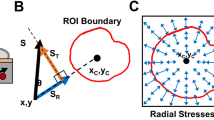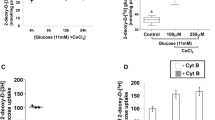Abstract
Electrical stimulation induces significant angiogenesis in vivo. We have shown that electrical stimulation of trophoblast cells has important functions in aspects of angiogenesis. In this study, we investigated the effects of a direct current electrical field on trophoblast angiogenic tube formation. A 6-hour exposure to electric fields ranging from 50 to 150 mV/mm dose dependently increased tube growth and network formation. Additionally, the effect was time dependent, with increased tube formation occurring between 4 and 8 hours, indicating stimulation of trophoblast cell angiogenesis. Electrical fields of small physiological magnitude stimulated vascular endothelial growth factor expression by trophoblast cells in the culture. Electric field treatment also resulted in activation of Akt, while the activity of extracellular-regulated kinase 1/2, p38, and c-Jun NH2-terminal kinase was not significantly changed. Pretreatment with the vascular endothelial growth factor receptor (VEGFR)-2 inhibitor, SU1498, resulted in potent inhibition of tube growth, and the Akt inhibitor, MK-2206 2HCl, significantly reduced electric field-stimulated tubulogenesis. These data suggest the importance of the VEGFR-2 signaling pathway during electric field-induced trophoblastic angiogenesis. This novel evidence indicates that endogenous electrical fields may promote angiogenesis of trophoblast cells by stimulating the VEGFR signaling pathway.
Similar content being viewed by others
References
Staun-Ram E, Shalev E. Human trophoblast function during the implantation process. Reprod Biol Endocrinol. 2005;3:56.
Caniggia I, Winter J, Lye SJ, Post M. Oxygen and placental development during the first trimester: implications for the pathophysiology of pre-eclampsia. Placenta. 2000;21(suppl A):S25–S30.
Whitley GS, Cartwright JE. Cellular and molecular regulation of spiral artery remodelling: lessons from the cardiovascular field. Placenta. 2010;31(6):465–474.
Zhao M, Bai H, Wang E, Forrester JV, McCaig CD. Electrical stimulation directly induces pre-angiogenic responses in vascular endothelial cells by signaling through VEGF receptors. J Cell Sci. 2004;117(3):397–405.
Bai H, Mccaig CD, Forrester JV, Zhao M. Direct current electric fields induce distinct preangiogenic responses in microvascular and macrovascular cells. Arterioscler Thromb Vasc Biol. 2004;24(7):1234–1239.
Li X, Kolega J. Effects of direct current electric fields on cell migration and actin filament distribution in bovine vascular endothelial cells. J Vasc Res. 2002;39(5):391–404.
Hudlicka O, Tyler KR. The effect of long-term intermittent high-frequency stimulation on capillary density and fibre profiles in rabbit fast muscles. J Physiol. 1984;353:435–445.
Hang J, Kong L, Gu JW, Adair TH. VEGF gene expression is upregulated in electrically stimulated rat skeletal muscle. Am J Physiol. 1995;269(2):H1827–H1831.
Annex BH, Torgan CE, Lin P, et al. Induction and maintenance of increased VEGF protein by chronic motor nerve stimulation in skeletal muscle. Am J Physiol. 1998;274(3 pt 2):H860–H867.
Michel JB, Ordway GA, Richardson JA, Williams RS. Biphasic induction of immediate early gene expression accompanies activity-dependent angiogenesis and myofiber remodeling of rabbit skeletal muscle. J Clin Invest. 1994;94(1):277–285.
Baba T, Kameda M, Yasuhara T, et al. Electrical stimulation of the cerebral cortex exerts antiapoptotic, angiogenic, and anti-inflammatory effects in ischemic stroke rats through phosphoinositide 3-kinase/Akt signaling pathway. Stroke. 2009;40(11):e598–e605.
Kanno S, Oda N, Abe M, et al. Establishment of a simple and practical procedure applicable to therapeutic angiogenesis. Circulation. 1999;99(20):2682–2687.
Zhang J, Ren R, Luo X, et al. A small physiological electric field mediated responses of extravillous trophoblasts derived from HTR8/SVneo cells: involvement of activation of focal adhesion kinase signaling. Plos One. 2014;9(3):e92252.
Chung IB, Yelian FD, Zaher FM, et al. Expression and regulation of vascular endothelial growth factor in a first trimester trophoblast cell line. Placenta. 2000;21(4), 320–324.
Shinkaruk S, Bayle M, Lain G, Deleris G. Vascular endothelial cell growth factor (VEGF), an emerging target for cancer chemotherapy. Curr Med Chem Anticancer Agents. 2003;3(2):95–117.
Sharkey AM, Cooper JC, Balmforth JR, et al. Maternal plasma levels of vascular endothelial growth factor in normotensive pregnancies and in pregnancies complicated by pre-eclampsia. Eur J Clin Invest. 1996;26(12):1182–1185.
Benaitreau D, Dos Santos E, Leneveu MC, et al. Effects of adiponectin on human trophoblast invasion. J Endocrinol. 2010;207(1):45–53.
Johnsen GM, Basak S, Weedon-Fekjaer MS, Staff AC, Duttaroy AK. Docosahexaenoic acid stimulates tube formation in first trimester trophoblast cells, HTR8/SVneo. Placenta. 2011;32(9):626–632.
Graham CH, Hawley TS, Hawley RG, et al. Establishment and characterization of first trimester human trophoblast cells with extended lifespan. Exp Cell Res. 1993;206(2):204–211.
Debnath J, Muthuswamy SK, Brugge JS. Morphogenesis and oncogenesis of MCF-10A mammary epithelial acini grown in three-dimensional basement membrane cultures. Methods. 2003;30(3):256–268.
Zhao M, Agius-Fernandez A, Forrester JV, McCraig CD. Orientation and directed migration of cultured corneal epithelial cells in small electric fields are serum dependent. J Cell Sci. 1996;109(pt 6):1405–1414.
Bai H, Forrester JV, Zhao M. DC electric stimulation upregulates angiogenic factors in endothelial cells through activation of VEGF receptors. Cytokine. 2011;55(1):110–115.
Song B, Gu Y, Pu J, Reid B, Zhao Z, Zhao M. Application of direct current electric fields to cells and tissues in vitro and modulation of wound electric field in vivo. Nat Protoc. 2007;2(6):1479–1489.
Ferrara N. The role of vascular endothelial growth factor in pathological angiogenesis. Breast Cancer Res Treat. 1995;36(10):127–137.
Risau W. Mechanisms of angiogenesis. Nature. 1997;386(6626):671–674.
Kim KJ, Li B, Winer J, Armanini M, Gillett N. Inhibition of vascular endothelial growth factor-induced angiogenesis suppresses tumor growth in vivo. Nature. 1993;362(6423):841–844.
Kendall RL, Thomas KA. Inhibition of vascular endothelial cell growth factor activity by an endogenously encoded soluble receptor. Proc Natl Acad Sci U S A. 1993;90(22):10705–10709.
Saleh M, Stacker SA, Wilks AF. Inhibition of growth of C6 glioma cells in vivo by expression of antisense vascular endothelial growth factor sequence. Cancer Res. 1996;56(2):393–401.
Sauer H, Bekhite MM, Hescheler J, Wartenberg M. Redox control of angiogenic factors and CD31-positive vessel-like structures in mouse embryonic stem cells after direct current electrical field stimulation. Exp Cell Res. 2005;304(2):380–390.
Carmeliet P. Angiogenesis in life, disease and medicine. Nature. 2005;438(7070):932–936.
Folkman J. Angiogenesis: an organizing principle for drug discovery? Nat Rev Drug Discov. 2007;6(4):273–286.
Shen M, Gao J, Li J, Su J. Effect of stimulation frequency on angiogenesis and gene expression in ischemic skeletal muscle of rabbit. Can J Physiol Pharmacol. 2009;87(5):396–401.
Cross MJ, Dixelius J, Matsumoto T, Claesson-Welsh L. VEGF-receptor signal transduction. Trends Biochem Sci. 2003;28(9):488–494.
Thakker GD, Hajjar DP, Muller WA, Rosengart TK. The role of phosphatidylinositol 3-kinase in vascular endothelial growth factor signaling. J Biol Chem. 1999;274(15):10002–10007.
Sheikh AQ, Taghian T, Hemingway B, Cho H, Kogan AB, Narmoneva DA. Regulation of endothelial MAPK/ERK signalling and capillary morphogenesis by low-amplitude electric field. J R Soc Interface. 2013;10(78):20120548.
Nie K, Henderson A. MAP kinase activation in cells exposed to a 60 Hz electromagnetic field. J Cell Biochem. 2003;90(6):1197–1206.
Friedman J, Kraus S, Hauptman Y, Schiff Y, Seger R. Mechanism of short-term ERK activation by electromagnetic fields at mobile phone frequencies. Biochem J. 2007;405(3):559–568.
Zhao M, Song B, Pu J, et al. Electrical signals control wound healing through phosphatidylinositol-3-OH kinase-gamma and PTEN. Nature. 2006;442(7101):457–460.
Ferrara N. Vascular endothelial growth factor as a target for anticancer therapy. Oncologist. 2004;9(suppl 1):2–10.
Das MK, Basak S, Ahmed MS, Attramadal H, Duttaroy AK. Connective tissue growth factor induces tube formation and IL-8 production in first trimester human placental trophoblast cells. Eur J Obstet Gynecol Reprod Biol. 2014;181:183–188.
Pandya AD, Das MK, Sarkar A, Vilasagaram S, Basak S, Duttaroy AK. Tube formation in the first trimester placental trophoblast cells: differential effects of angiogenic growth factors and fatty acids. Cell Biol Int. 2016;40(6):652–661.
Hotary KB, Robinson KR. Endogenous electrical currents and the resultant voltage gradients in the chick embryo. Dev Biol. 1990(1);140:149–160.
Metcalf MEM, Shi RY, Borgens RB. Endogenous ionic currents and voltages in amphibian embryos. J Exp Zool. 1994;268(4):307–322.
Levin M, Mercola M. Gap junctions are involved in the early generation of left-right asymmetry. Dev Biol. 1998;203(1):90–105.
Levin M, Mercola M. Gap junction-mediated transfer of left-right patterning signals in the early chick blastoderm is upstream of Shh asymmetry in the node. Development. 1999;126(21):4703–4714.
Levin M, Thorlin T, Robinson KR, Nogi T, Mercola M. Asymmetries in H+/K+-ATPase and cell membrane potentials comprise a very early step in left-right patterning. Cell. 2002;111(1):77–89.
Barker AT, Jaffe LF, Vanable JW. The glabrous epidermis of cavies contains a powerful battery. Am J Physiol. 1982;242(3):358–366.
Chiang M., Robinson KR, Vanable JW. Electrical fields in the vicinity of epithelial wounds in the isolated bovine eye. Exp Eye Res. 1992;54(6):999–1003.
Sta Iglesia DD, Vanable JW. Endogenous lateral electric fields around bovine corneal lesions are necessary for and can enhance normal rates of wound healing. Wound Repair Regen. 1998;6(6):531–542.
Author information
Authors and Affiliations
Corresponding author
Additional information
Authors’ Note
L.Y. and L.G. performed experiments, analyzed data, and contributed to the writing of the manuscript. P.F., Y.L., W.X., R.L., and X.W. performed experiments and analyzed data. Y.Z. and Y.L. contributed reagents/materials/analysis tools. H.B. conceived the project, analyzed data, and contributed to the writing of the manuscript.
Rights and permissions
About this article
Cite this article
Ye, L., Guan, L., Fan, P. et al. Effect of a Small Physiological Electric Field on Angiogenic Activity in First-Trimester Extravillous Trophoblast Cells. Reprod. Sci. 26, 745–756 (2019). https://doi.org/10.1177/1933719118792102
Published:
Issue Date:
DOI: https://doi.org/10.1177/1933719118792102




